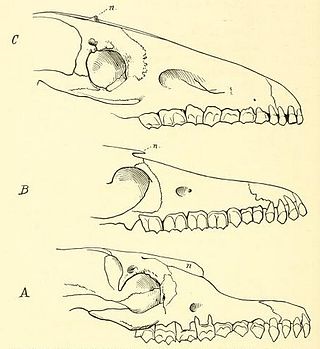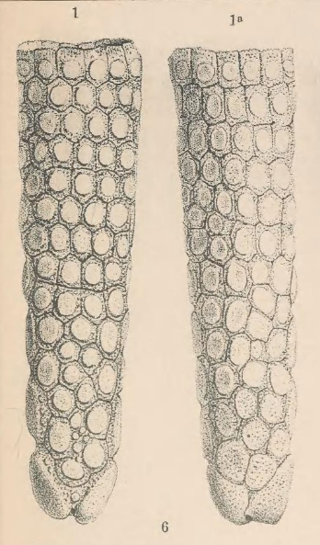Classification
The genus Plohophorus was first described in 1887 by Florentino Ameghino, based on fossil remains found in Upper Miocene terrains of Argentina. The type species is Plohophorus figuratus; several other species from the Late Miocene and the Early Pliocene were also attributed to the genus, such as Plohophorus paranensis, P. sygmaturus, P. cuneiformis, P. coronatus, P. ameghini, P. araucanus, P. australis and P. orientalis. According to the most recent revision of the genus, however, only the four first species are still considered valid. [1] In 2011, a species from the Late Pliocene of Colombia, P. barrancalobensis, was described.
Plohophorus was a rather derived glyptodont, representative of the tribe Doedicurini. Its name is an anagram of Hoplophorus , a similar but more recent genus.

Scalabrinitherium is an extinct genus of mammals of the family Macraucheniidae. Fossils of this animal were found among the fossils of prehistoric xenarthrans in the Ituzaingó Formation of Argentina.

Hoplophorus is an extinct genus of glyptodont, a subfamily of armadillos. The only confidently known species was H. euphractus, found in Pleistocene deposits in Brazil, though fossils possibly from another species are known from Bolivia.

Eleutherocercus was a genus of glyptodonts that lived during the Late Miocene and Early Pliocene in South America. Fossils of the genus have been found in the Huayquerian Ituzaingó Formation and the Montehermosan Monte Hermoso Formation in Argentina.

Neosclerocalyptus was an extinct genus of glyptodont that lived during the Pliocene, Pleistocene, and Holocene of Southern South America, mostly Argentina. It was small compared to many Glyptodonts at only around 2 meters long and 360 kilograms.

Lomaphorus is a possibly dubious extinct genus of glyptodont that lived during the Pleistocene in eastern Argentina. Although many species have been referred, the genus itself is possibly dubious or synonymous with other glyptodonts like Neoslerocalyptus from the same region.

Pseudotypotherium is an extinct genus of Notoungulates, belonging to the suborder Typotheria. It lived from the Late Miocene to the Late Pliocene, and its fossilized remains were discovered in South America.
Kraglievichia is an extinct genus of cingulate belonging to the family Pampatheriidae. It lived from the Late Miocene to the Early Pliocene, and its fossilized remains were discovered in South America.

Stenotatus is an extinct genus of cingulate, belonging to the family Dasypodidae. It lived from the Early to the Late Miocene in South America.
Proeuphractus is an extinct genus of xenarthran, related to the modern armadillos. It lived from the Early to the Late Miocene, and its fossilized remains were discovered in South America.

Prozaedyus is an extinct genus of chlamyphorid armadillo that lived during the Middle Oligocene and Middle Miocene in what is now South America.
Protoglyptodon is an extinct genus of glyptodont. It lived during the Late Miocene, and its fossilized remains were found in South America.
Palaehoplophorus is an extinct genus of glyptodont. It lived from the Middle to the Late Miocene, and its fossilized remains were discovered in South America.
Phlyctaenopyga is an extinct genus of Glyptodont. It lived from the Late Miocene to the Early Pliocene, and its fossilized remains were discovered in South America.
Neuryurus is an extinct genus of glyptodont. It lived from the Late Pliocene to the Early Holocene, and its fossilized remains were discovered in South America.
Comaphorus is a dubious extinct genus of glyptodont. It lived during the Late Miocene in Argentina, but only one fossil has ever been referred to the animal.
Asterostemma is an extinct genus of glyptodont. It lived during the Middle Miocene, and its fossilized remains were discovered in South America.

Cochlops is an extinct genus of glyptodont. It lived from the Early to Middle Miocene, and its fossilized remains have been found in South America.
Dasypus neogaeus is an extinct species of armadillo, belonging to the genus Dasypus, alongside the modern nine-banded armadillo. The only known fossil is a single osteoderm, though it has been lost, that was found in the Late Miocene strata of Argentina.
Caiman australis is an extinct species of caiman described in 1858 on the basis of a left maxilla that was collected from the Upper Miocene age Ituzaingó Formation of Entre Rios, Argentina.

Peltephilidae is a family of South American cingulates (armadillos) that lived for over 40 million years, but peaked in diversity towards the end of the Oligocene and beginning of the Miocene in what is now Argentina. They were exclusive to South America due to its geographic isolation at the time, one of many of the continent's strange endemic families. Peltephilids are one of the earliest known cingulates, diverging from the rest of Cingulata in the Early Eocene.
This page is based on this
Wikipedia article Text is available under the
CC BY-SA 4.0 license; additional terms may apply.
Images, videos and audio are available under their respective licenses.












